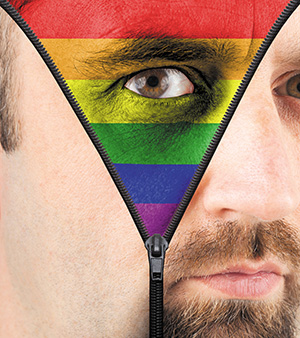Life Beyond Therapy
Michael Kimmel
It’s pretty easy to feel anxious these days, especially with climate change, attacks on LGBTQ rights and a government led by someone as mentally unstable as Donald Trump.
After suffering from panic attacks myself and helping my clients with anxiety, worry, fears and phobias, here are some practical tools that you can add to your emotional health toolkit.
What exactly is anxiety?
Anxiety is a fear of the future and an anticipation of some kind of danger. We all have a bit of this hard-wired worry. It’s one of the reasons we humans have managed to survive the dinosaurs, decades of homophobia and persecution, AIDS and way too many lousy presidents/governments.
Full-blown clinical anxiety happens when our common fears get amplified — as if someone jacked up the volume — and they’re no longer based in reality. If you just ignore your anxiety, it may eventually go away. But, for many of us, our anxiety keeps us from doing things we want/need to do. Unaddressed, it makes our world smaller and scarier.
Look for physical signs of anxiety
You may notice a rapid heartbeat, your skin may feel clammy because your heart is racing, or you may become angry or tearful. Anxiety is about anticipating a negative, fearful future, so there are a lot of fearful thoughts spinning in your head, which are hard to get rid of. What can you do?
Help yourself relax
Start by calming yourself down and getting more oxygen to your brain (we often breathe shallowly when we’re afraid). At a time like this, logic isn’t very helpful. Your body is on autopilot and doesn’t want to let your wisdom speak up.
Taking a few deep breaths is a simple way to calm down. Or you might find going for a walk works well for you, listening to certain music, playing with your pet, or talking with your best friend. Have a repertoire of ways to help yourself relax. Write them down. Use them when you need them.
Now that you’ve managed to calm your body down a bit, it’s time to …
Validate your fears
Don’t punish yourself for being anxious — that’ll just make it worse. Instead, validate your worries, no matter how irrational they may seem. It’s time to talk to your inner child. “Who is that?” you may wonder. It’s the historical “you” that is usually feeling the fear. The next time you feel anxious or afraid, close your eyes and ask yourself, “How old do I feel right now?” If you feel 5 years old, then that’s the current age of your fearful inner child. Talk to this 5-year-old as you would to a real child. You could say something like:
“I know you’re afraid and that these are scary feelings. Tell me what you’re afraid of.” And listen. Really listen.
Let your inner 5-year-old child know that you respect their fear and you’ll be there to help them through it. Perhaps as a kid there was no one to comfort you. Well, that’s not true anymore: your scared little kid now has big, strong, smart adult you on their side. They will never be so alone and powerless again.
Help your inner child face their fears
You want to respect your inner child’s fear, but not let it run your life. In the big picture, it’s important to face your fears, otherwise you strengthen the fear and anxiety. If you tell your scared inner child, “It’s okay to run away and avoid things that are scary,” your fears just get bigger.
Instead, help yourself (and your inner child) to understand that some things in life are difficult and scary; but, we can do them anyway. Push yourself a little bit, but not so much that you freak yourself out. You want to be a good parent to yourself by being loving and encouraging. How do you walk that fine line?
Build up your confidence with baby steps
Slowly begin to expose yourself to that scary experience/person/event. Helping people create a plan to face their fears is a big part of my job as a psychotherapist. Anxiety usually responds well to cognitive behavioral therapy, and a big part of that is exposure therapy. You can Google it, ask me about it, or check out the book “Feeling Good” by David D. Burns, MD ($1.27 on Amazon).
If you’re afraid of going to a big, glamorous holiday party, start to gradually expose yourself to that kind of scary situation. You could begin by putting yourself in social situations that only scare you a little bit. Get comfortable with those and slowly work your way up to that intimidating holiday party. Take it in baby steps and give yourself rewards when you make progress.
If you feel completely overwhelmed by your anxiety and none of this stuff helps, please consider getting professional help. Cognitive therapy can be extremely helpful in dealing with panic, phobias and fears. How do I know? I’ve been on both sides of the (therapy) chair, as client and therapist.
The good news? Anxiety is not only incredibly common but also treatable. Don’t suffer unnecessarily. Get help and feel better.









